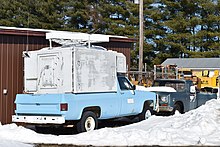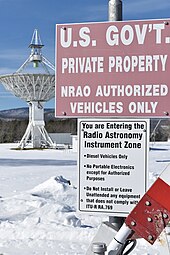Coordinates: 38°22′30″N 79°30′00″W / 38.375°N 79.5°W / 38.375; -79.5
The National Radio Quiet Zone (NRQZ) is a large area of land in the United States designated as a radio quiet zone, in which radio transmissions are heavily restricted by law to facilitate scientific research and the gathering of military intelligence. Roughly half of the zone is located in the Blue Ridge Mountains of west-central Virginia while the other half is the Allegheny Mountains of east-central West Virginia; a small part of the zone is in the southernmost tip of the Maryland panhandle.
Location
The Quiet Zone is an approximate rectangle of land, 107.0 miles (172.2 km) on the north edge, 109.6 miles (176.4 km) on the south edge and 120.9 miles (194.6 km) on the east and west edges, comprising approximately 13,000 square miles (34,000 km2; 8,300,000 acres). It straddles the borders of Virginia and West Virginia, and also includes a sliver of Maryland. The NRQZ is centered between the Green Bank Observatory in Green Bank, West Virginia, and Sugar Grove Station in Sugar Grove, West Virginia. It includes all land with latitudes between 37° 30′ 0.4″ N and 39° 15′ 0.4″ N, and longitudes between 78° 29′ 59.0″ W and 80° 29′ 59.2″ W.[1]
Restrictions

An older model of patrol truck used to identify source of radio interference
[2]
A modern patrol truck equipped with detectors
[3]Most broadcast transmitters in the core of the Quiet Zone are forced to operate at reduced power and use highly directional antennas. This makes cable and satellite all but essential for acceptable television in much of the region. Restrictions on transmissions are tightest within ten miles (16 km) of the Green Bank and Sugar Grove facilities,[4] where most omnidirectional and high-power transmissions are prohibited.
Not all radio transmissions are prohibited in the core of the Quiet Zone. For example, emergency service (police, fire, and ambulance) radios and CB radios are permitted. However, large transmitter owners must typically coordinate their operations with the Green Bank Observatory. The only broadcast radio stations are part of the Allegheny Mountain Radio network, with just one station in the AM band, and several low-power FM broadcast translator stations. Exceptions to restrictions are usually determined on a case-by-case basis, with preference given to public safety concerns, such as remote alarm systems, repeaters for emergency services, and NOAA Weather Radio.
The most severe restrictions imposed on the general public are only in place within the 20-mile (32 km) radius of the Green Bank Observatory.[5] The Observatory actively polices the area for devices emitting noticeably high amounts of electromagnetic radiation such as microwave ovens, Wi-Fi routers and faulty electrical equipment and request citizens discontinue their usage. They possess no legal powers of enforcement[6] (although the FCC can still impose a fine of $50 on violators[7]), but will work with residents to find solutions.[8][9]
Cellular telephone use in the core of the zone is also highly restricted.[5]
| “ | "In Green Bank, though, the rules are even stronger, so much that some residents who are in direct sight of the radio telescope receivers, can't use Wi-Fi devices and even microwave ovens in all Green Bank Radio Astronomy housing units. Directional cellphone service areas are very limited, such as in Snowshoe Mountain Resort in nearby Snowshoe, West Virginia, one of the state's major ski areas."[10] | ” |
Zones of protection
The Green Bank Interference Protection Group maintains policies to manage radio-frequency interference (RFI) by dividing into five zones based on available legal instruments.[11][12]
Zone 1 and zone 2 are located within the property of the Green Bank Observatory. The entire property is designed as zone 1 except small portions (such as housing, visitor and laboratory areas) that are designed as zone 2. Zone 1, also called Radio Astronomy Instrument Zone, restricts intentional radiators to only those are deemed essential. All unintentional radiators must be operated within the ITU-R RA.769 recommendations on protection criteria used for radio astronomical measurements. Gasoline-powered motor vehicles are forbidden within zone 1 as the ignition system on spark-ignited engines generates noticeable radio interference, resulting in all vehicles and equipment needing to be diesel-powered.[13] Zone 2, also called Observatory Building Zone, allows intentional radiators licensed by National Radio Quiet Zone, but not other radiators such as Wi-Fi, cordless phones, and other wireless equipment. Certain types of unintentional radiators are allowed, however digital cameras are prohibited, although film photography is allowed.[14]
Zone 3 and zone 4 are governed by the Radio Astronomy Zoning Act which is the Chapter 37A of the West Virginia Code. It strictly regulates radio transmitters within 2 miles (3.2 km) and within 10 miles (16 km) of the Green Bank Observatory, respectively.[4] Within these zones, interference to observations will be identified and documented. The owners of the offending equipment will be personally visited to request cooperation in eliminating the interference. Enforcement is used as a last resort. Enforcement in zone 4 may be more lenient than the limit set in the Chapter 37A.
Zone 5 is the boundary of National Radio Quiet Zone; the National Radio Quiet Zone Administrator at the Green Bank Observatory manages the enforcement policies.
The Federal Communications Commission (FCC) created the Quiet Zone in 1958 to protect the radio telescopes at Green Bank and Sugar Grove from harmful interference.[15] Today, the Green Bank Observatory oversees the Quiet Zone.
The Quiet Zone also protects the antennas and receivers of the U.S. Navy's Information Operations Command (NIOC) at Sugar Grove. The NIOC is the location of electronic intelligence-gathering systems, and is today said to be a key station in the ECHELON system operated by the National Security Agency (NSA).[16]
The area has also attracted people who believe they suffer from electromagnetic hypersensitivity.[17][18][19]
Counties inside the NRQZ
Maryland counties
Virginia counties
- See also List of radio stations in Virginia, which includes several AM and FM stations within the zone.
West Virginia counties
- See also List of radio stations in West Virginia, which includes several AM and FM stations within the zone.
Cities inside the NRQZ
Virginia cities
West Virginia cities
- Outside
Clarksburg, West Virginia, and Lynchburg, Virginia are just outside the Quiet Zone.
See also
References
- ^ "National Radio Quiet Zone". National Radio Astronomy Observatory. Retrieved February 20, 2015.
- ^ Casto, James E. (July 9, 2014). "NRAO Vehicle Fleet". The State Journal. Retrieved October 31, 2016.
- ^ Bucktin, Christopher (July 28, 2015). "Telescope Town can hear to within second of the Big Bang but won't let locals use mobiles". Mirror. Retrieved October 31, 2016.
- ^ a b "West Virginia Code, Chapter 37A". Chuck Niday - National Radio Astronomy Observatory. Retrieved October 8, 2013.
- ^ a b Hu, Elise (October 8, 2013). "Enter The Quiet Zone: Where Cell Service, Wi-Fi Are Banned". National Public Radio. Retrieved October 8, 2013.
To keep the zone protected from signals that could confuse the telescope, Niday and others from the NRAO drive the 20-mile radius around the Green Bank Telescope weekly, policing for possible interference.
- ^ Holba, Emile; Hall, Sara Jane (May 19, 2015). "The Quiet Zone: Where mobile phones are banned". BBC. Retrieved July 14, 2016.
- ^ "West Virginia Code, Chapter 37A". National Radio Astronomy Observatory. Retrieved July 14, 2016.
- ^ Sizemore, Wes; Acree, Jeff. "The National Radio Quiet Zone" (PDF). NRAO. Retrieved July 14, 2016.
NRAO operates the National Radio Quiet Zone at Green Bank. We briefly outline its salient characteristics, and our experience with its day to day operation.
- ^ ""National Radio Quiet Zone"... (Parkersburg, Elkins: construction, living, zip code) - West Virginia (WV) - City-Data Forum". city-data.com. Retrieved July 14, 2016.
- ^ Sterman, Joce (June 26, 2016). "'Full Measure': The No-Fi zone". WGME. Retrieved April 21, 2017.
- ^ Beaudet, C.; Clark, C.; Niday, C.; Ghigo, F.; Ford, J.; McCullough, R.; Sizemore, W.; Woody, P. (January 24, 2007). The Green Bank Interference Protection Group: Policies for RFI Management (PDF) (Report).
- ^ "NRAO Green Bank Policies for RFI Management". Retrieved October 31, 2016.
- ^ "NRAO Green Bank Site RFI Regulations for Visitors" (PDF). National Radio Astronomy Observatory. p. 2. Retrieved October 14, 2016.
- ^ https://www.nytimes.com/2019/06/21/opinion/sunday/wifi-wilderness-privacy-reserves.html
- ^ "National Radio Quiet Zone - National Radio Astronomy Observatory".
- ^ "Interception Capabilities 2000, Sugar Grove, Virginia – COMSAT interception at ECHELON site". Interception of Communications Section. Leeds, UK: Cyber-Rights & Cyber-Liberties (UK). May 11, 1999. Archived from the original on May 30, 2008. Retrieved September 14, 2011.
Interception Capabilities 2000 Report to the Director General for Research of the European Parliament (Scientific and Technical Options Assessment programme office) on the development of surveillance technology and risk of abuse of economic information.
- ^ O'Brien, Jane; Danzico, Matt (September 12, 2011). "'Wi-fi refugees' shelter in West Virginia mountains". BBC News. Retrieved September 13, 2011.
- ^ "The town that banned Wi-Fi". The Guardian. Retrieved June 21, 2015.
- ^ https://www.nytimes.com/2019/06/21/opinion/sunday/wifi-wilderness-privacy-reserves.html
External links
from Hacker News https://ift.tt/1LDy5yh


No comments:
Post a Comment
Note: Only a member of this blog may post a comment.